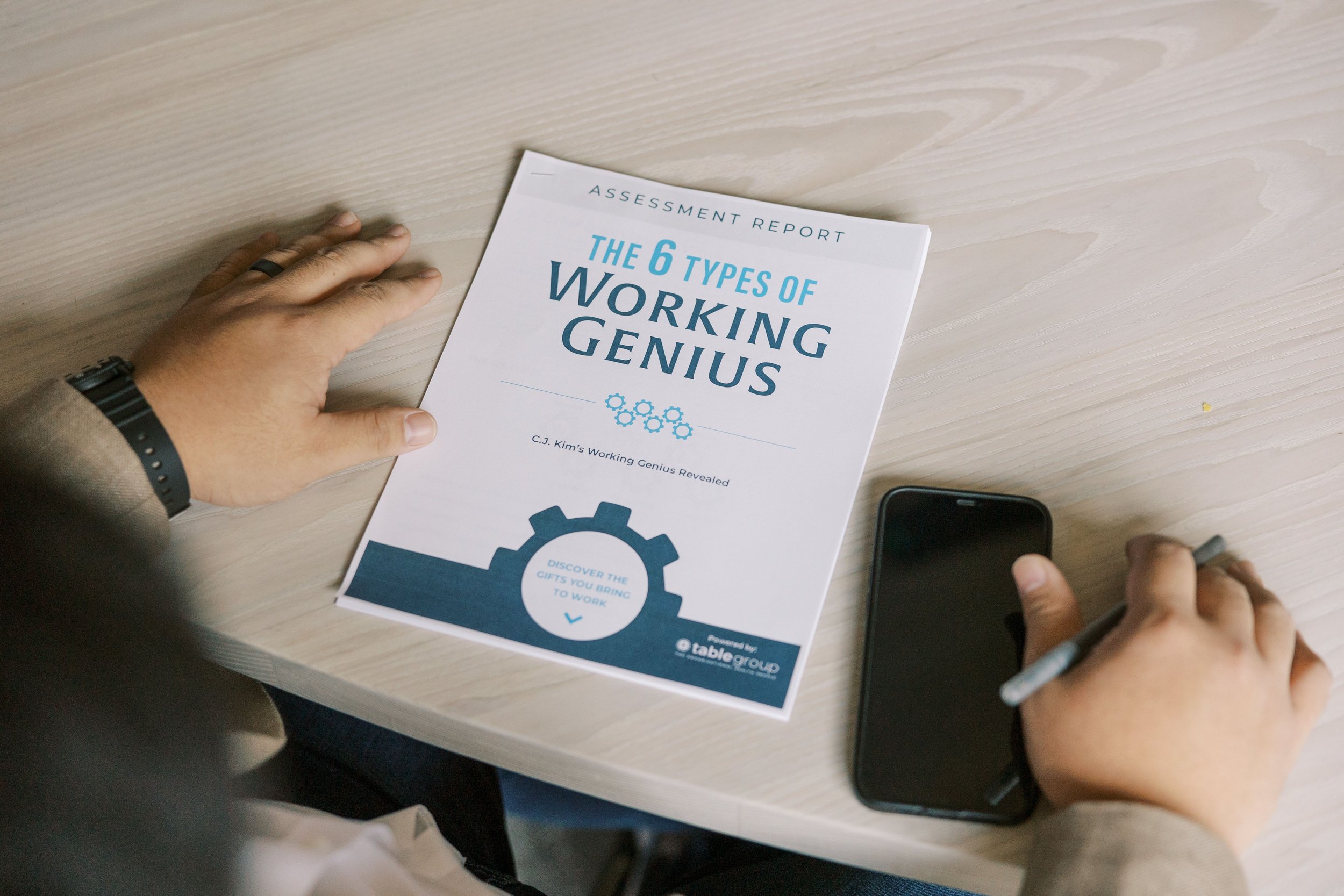From Chaos to Cohesion: How the Six Types of Working Genius Can Transform Your Team
If you lead a team or are a team member, you are all-too-aware of the ever-evolving challenges that can hinder team effectiveness and productivity. One common pain point that teams across industries experience is the difficulty of leveraging the diverse skills and perspectives of each contributor. Any degree of team disintegration can lead to a variety of challenges, including low morale, lack of creativity, analysis paralysis, and impaired problem-solving, among other frustrations.
As a leadership and team coach, I use a number of assessments to address these challenges and provide opportunities for individual and team development, including …👇🏻
Clifton StrengthsFinder identifies your top five talents and how to leverage them for success.
The Emotional Quotient Inventory (EQi-2.0) measures individual emotional intelligence in five specific competency areas, including self-perception, self-expression, interpersonal skills, decision-making, and stress tolerance.
The Enneagram categorizes you into one of nine dynamic personality types, revealing your underlying motivations and drivers.
The Five Dysfunctions of a Team gives insight into the specific areas in which your team lacks effectiveness.
The Intercultural Development Inventory assesses your intercultural competence and how you interact with people from different cultures.
The Myers-Briggs Type Indicator (MBTI) identifies your personality preferences in terms of introversion/extraversion, sensing/intuition, thinking/feeling, and judging/perceiving.
I recommend these assessments for a variety of team development goals and feel they cover the bases really well. So when I first encountered Patrick Lencioni’s The Six Types of Working Genius model, I admit I was skeptical. I felt it would be challenging to compete with the many other well-established assessments and bring some truly unique value to team development. However, after exploring Lencioni’s framework in greater depth and becoming a certified Working Genius coach, I’m happy to report that I am finding this tool to be incredibly insightful.
One key feature that sets The Working Genius model apart is its focus on how teams can achieve greater results with more strategic collaboration centered around specific areas of work they find most energizing
Developed by Patrick Lencioni and his team in 2022, this model identifies six distinct types of working geniuses that individuals exhibit, each contributing uniquely to the team processes of ideation, activation, and implementation. The model encourages us to consider how areas of individual genius can be leveraged to create a more innovative, effective, and efficient workflow.
One important note: it’s tempting to think that your Geniuses are synonymous with your strengths. However, the assessment is actually evaluating which areas of work you find the most energy in. Although you may be highly skilled in your Genius areas, the purpose of the assessment is to reveal how you are most energized, not where you are most gifted.
The Six Types of Working Genius offers us practical insight into how to keep momentum flowing and achieve optimal results through three critical phases of teamwork:
ideation
activation
implementation
If you are a team leader or you supervise (or coach) team leaders, I recommend to check out the Working Genius as a dynamic approach to building a healthy, thriving team. In this post, I’m going to describe each genius and explore how teams can practically apply this tool to enhance teamwork and productivity.
1. The Genius of Wonder (W)
What It Is: The Genius of Wonder is all about questioning the status quo and envisioning new possibilities. Individuals with this genius are energized by identifying problems and opportunities that others might overlook. They are naturally curious and enjoy exploring what could be, often driving innovation and creativity.
How to Use It Practically: Teams should leverage the Genius of Wonder at the brainstorming phase of projects. Encourage these individuals to voice their thoughts on potential improvements and new ideas. Their ability to spot gaps and envision future possibilities can set the stage for groundbreaking solutions and strategies.
2. The Genius of Invention (I)
What It Is: The Genius of Invention involves generating creative solutions and novel approaches to challenges. Those with this genius enjoy being imaginative and resourceful, and are likely looking for inventive ways to solve problems and improve processes.
How to Use It Practically: Deploy the Genius of Invention during the ideation phase to explore unconventional solutions and creative strategies. These individuals are ideal to rely on for brainstorming sessions where out-of-the-box thinking is encouraged. Their inventive mindset can lead to breakthroughs that set the team apart from competitors.
3. The Genius of Discernment (D)
What It Is: The Genius of Discernment involves evaluating ideas and solutions with a keen sense of judgment. Those with this genius find it rewarding to assess the viability and quality of concepts and often make thoughtful decisions based on their intuition and experience.
How to Use It Practically: In project development, leverage the Genius of Discernment during the evaluation stage. These team members can provide valuable feedback on proposed ideas, ensuring that only the most promising concepts move forward. Their discerning nature helps in refining ideas and avoiding potential pitfalls.
4. The Genius of Galvanizing(G)
What It Is: The Genius of Galvanizing is about energizing and motivating others to take action. People with this genius are natural leaders who can rally a team around a shared vision and inspire them to pursue goals with enthusiasm and determination.
How to Use It Practically: Leverage the Genius of Galvanizing to inspire the team. These individuals tend to have natural energy for leading meetings, launching new projects, and maintaining momentum. Their ability to energize the team can be crucial in overcoming obstacles and achieving ambitious targets.
5. The Genius of Enablement (E)
What It Is: The Genius of Enablement involves helping others succeed by providing support and encouragement. Those with this genius gain energy from creating an environment where team members feel empowered and motivated to contribute their best work.
How to Use It Practically: Utilize the Genius of Enablement to foster a positive team culture and enhance collaboration. These individuals are typically fulfilled by mentoring, facilitating communication, and ensuring that all team members have the resources they need to perform effectively. Their supportive nature can boost morale and drive collective success.
6. The Genius of Tenacity (T)
What It Is: The Genius of Tenacity is focused on executing and finishing tasks with a high level of efficiency and attention to detail. Individuals with this genius enjoy bringing projects to a successful conclusion, ensuring that all elements are addressed and nothing is left incomplete.
How to Use It Practically: Deploy the Genius of Tenacity to handle project management and ensure that deadlines are met. These individuals are ideal for roles that require meticulous follow-through and quality assurance. Their ability to complete tasks and finalize projects ensures that the team’s hard work is not undone by oversight or inattention.
Balancing Innovation and Implementation
Teams often struggle to balance innovation and implementation because they prioritize one over the other. This can lead to a lack of creativity or an inability to execute on ideas. Additionally, teams may have difficulty communicating and collaborating effectively, which can hinder their ability to work together towards a common goal. One of the exciting contributions of Working Genius is that it helps teams integrate each person’s area of strength so that all teamwork phases, from idea generation to evaluation to execution, are leveraged for the task at hand.
Let’s take a look at some of the distinctive balancing features of The Working Genius tool. The six geniuses are categorized into two broad groups based on their nature of contribution to teamwork and problem-solving: responsive and disruptive.
Individuals who excel in the Responsive Geniuses (Wonder, Discernment, & Enablement) most often respond to the environment and external stimuli. They thrive when they can react to the ideas, needs, or situations presented to them.
Individuals who excel in the Disruptive Geniuses (Invention, Galvanizing, & Tenacity) are instrumental in initiating change and driving innovation. They enjoy challenging the norm and pushing boundaries to create new possibilities.
For a team to function optimally, a balance between responsive and disruptive geniuses is critical. For example:
Wonder (responsive) is complemented by Invention (disruptive) to create tangible ideas to solve the problems identified. When left to its own devices, Wonder alone may divulge in excessive curiosity or questioning, which can lead to irrelevant tangents or a state of indecision.
Invention (disruptive) can benefit from being paired with Discernment (responsive) to ensure that new ideas are viable and aligned with practical considerations. Invention on its own may pursue change for the sake of novelty, without observing the needs represented in the environment, and without considering how feasible an idea is to implement.
This paradigm of responsive—-disruptive geniuses highlights an important teamwork truth: each of us need the strengths of our team members to help us effectively achieve our collaborative goals. The Working Genius framework gives us a tangible tool to evaluate what we need more or less of in our team dynamics.
Understanding Your Working Genius Profile
To find out your genius take the assessment at WorkingGenius.com. There are 42 questions, and it takes about ten minutes to complete.
After taking the assessment, you will find that your six geniuses are categorized in three ways:
Working Genius: These are your two strongest geniuses — what you’re naturally good at and what energizes you.
Working Competency: This represents the two areas you can handle effectively but you don’t particularly excel at or enjoy. The competencies sit in the middle ground between your working genius and your working frustration.
Working Frustration: These two areas are the types of work you find frustrating or draining. They tend to sap your enthusiasm and energy.
Teamwork Makes the Dreamwork, Working Genius Style
Once individuals on your team have received their individual Working Genius profiles, you are now empowered with insight to help you take your teamwork to the next level. Here are my top tips for teams to get the most out of this assessment:
Identify areas of team strength: Fill out a Working Genius team map so that everyone can understand each team member’s primary and secondary geniuses. This awareness helps in assigning roles and tasks that align with individual strengths.
Enhance communication: Provide time for open communication about each person’s genius and how it contributes to the team’s goals. Understanding and respecting different working styles can improve team dynamics and reduce conflicts.
Understand your team’s trends: Reviewing your completed Working Genius team map should provide greater awareness when the team is missing an area of genius or when there is an excess of genius. Take time to thoughtfully consider how the gaps or the abundance of certain geniuses are influencing your team.
Create intentional partnerships: Encourage collaboration among different types of geniuses. For instance, combining the Genius of Wonder with the Genius of Discernment can lead to innovative yet practical solutions.
Optimize workflow: Structure workflows and project phases to leverage the unique strengths of each genius. This ensures that every phase of a project, from ideation to completion, is handled by those best suited for the task.
I’m thoroughly enjoying the profound simplicity of the model and am now using it as one of my go-to tools for teams.














